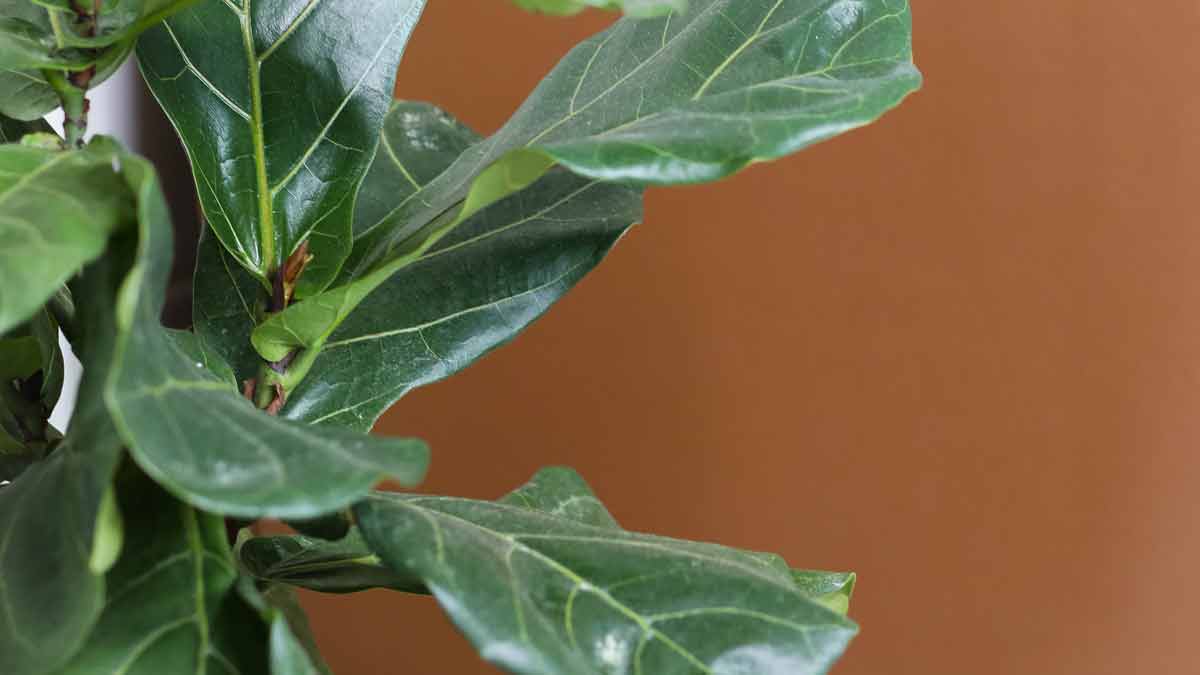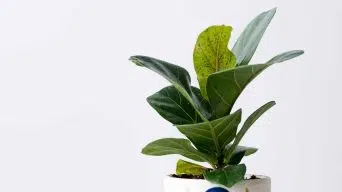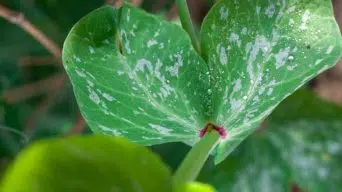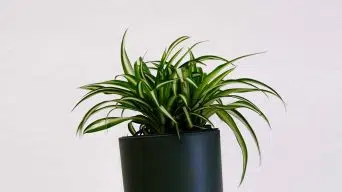Ficus trees are popular houseplants because they tolerate various growing conditions. However, even the hardiest ficus can develop problems if it isn’t cared for properly.
One common issue is white spots on the leaves.
There are several possible causes of white spots on ficus leaves, including fungal diseases, pests, and environmental stress.
In most cases, the problem can be resolved with some simple treatment.
Here’s a closer look at some common causes of white spots on ficus leaves, along with some tips on resolving the issue.
What Causes White Spots on Ficus Leaves?
There are several reasons your ficus tree may have white spots on its leaves.
These include:
1. Powdery Mildew
Powdery mildew is a fungus that can affect outdoor and indoor plants.
It thrives in warm, humid environments and appears as a white, powdery substance on the leaves and stems of plants.
Although powdery mildew is not deadly to plants, it can cause the leaves to turn yellow and drop off.
How To Tell If Your Ficus Has Powdery Mildew
There are a few tell-tale signs that your ficus has powdery mildew, including:
- White, powdery spots on the leaves
- Yellowing or wilting leaves
- Leaves that drop off prematurely
How To Treat Powdery Mildew
If you think your ficus has powdery mildew, it’s essential to take action immediately.
The fungus can spread quickly, so it’s important to nip it in the bud.
There are a few different ways to treat powdery mildew, including:
- Use neem oil. Neem oil is a natural fungicide that can be used to treat powdery mildew. Apply it to the affected leaves using a spray bottle.
- Make a baking soda spray. Combine 1 teaspoon of baking soda with 1 quart of water and use it to spray down the affected leaves.
- Use milk. Mix 1 part milk with 9 parts water and use it to spray the affected leaves.
- Remove affected leaves. If the fungus has spread to many leaves, you may need to remove and dispose of them to prevent the fungus from spreading further.
How To Prevent Powdery Mildew
Water droplets often spread powdery mildew, so it’s important to avoid wetting the leaves of your ficus when you water it.
It’s also a good idea to increase air circulation around the plant by opening windows or using a fan.
In addition, powdery mildew can often be prevented using a preventative fungicide.
There are a few different types of fungicides that can be used, including neem oil, sulfur, and copper.
2. Pest Infestation
Pests are another common cause of white spots on ficus leaves.
Aphids, scale insects, and mealybugs are all common pests that can infest ficus trees.
These pests feed on the sap of plants, which can cause the leaves to turn yellow or brown and eventually drop off. This damage can result in white spots transitioning into unsightly black spots on the foliage.
In addition, pests can also spread diseases, so getting rid of them as soon as possible is essential.
How To Tell If Your Ficus Has Pests
There are a few signs that your ficus has pests, including:
- White spots or webbing on the leaves
- Leaves that are discolored or wilting
- Holes in the leaves
- A sticky substance on the leaves or stems
How To Treat Pests
If you think your ficus has pests, there are several ways to get rid of them.
These include:
- Use insecticidal soap. Insecticidal soap is a safe and effective way to eliminate most types of pests. Mix it with water and spray it on the affected leaves.
- Use a neem oil solution. Neem oil is a natural insecticide used to get rid of pests. Mix it with water and spray it on the affected leaves.
- Use rubbing alcohol. Rubbing alcohol will kill most types of pests on contact. Dab it on the pests using a cotton ball or Q-tip.
- Remove affected leaves. If the pests have infested many leaves, you may need to remove and dispose of them to prevent the pests from spreading further.
How To Prevent Pests
There are a few things you can do to prevent pests from infesting your ficus, including:
- Keep your ficus tree clean. Pests are attracted to dirty trees, so make sure to keep the leaves and branches clean.
- Inspect your ficus regularly. Check the leaves and stems for any signs of pests.
- Quarantine new plants. If you’re adding new plants to your home, inspect them for pests before adding them to your ficus collection.
- Get rid of any dead leaves or branches. Pests are attracted to dead plant matter, so remove it from your ficus tree as soon as possible.
3. Nutrient Deficiencies
Nutrient deficiencies are another common cause of white spots on ficus leaves.
Ficus trees need a wide range of nutrients, including iron, calcium, magnesium, copper, and manganese.
If your tree isn’t getting enough of these nutrients, it will show signs of distress.
The most common symptom of a nutrient deficiency is chlorosis or yellowing of the leaves.
This is usually followed by white spots and, eventually, leaf drop.
How To Tell If Your Ficus Is Deficient In Nutrients
There are a few signs that your ficus is deficient in nutrients, including:
- Yellowing of the leaves
- White spots on the leaves
- Leaf drop
- Stunted growth
How To Treat Nutrient Deficiencies
If you think your ficus is deficient in nutrients, you can do a few things to help it.
These include:
- Fertilize your ficus tree. Use a fertilizer that is high in the nutrient that your tree is deficient in.
- Add compost to the soil. Compost is a great way to add nutrients to the soil and improve the overall health of your ficus tree.
- Use foliar feeding. Foliar feeding is a process where you apply nutrients directly to the plant’s leaves. This is a great way to correct a nutrient deficiency quickly.
How To Prevent Nutrient Deficiencies
There are a few things you can do to prevent nutrient deficiencies, including:
- -Test the soil before planting. This will help you to know what nutrients are already in the soil and which ones your ficus tree will need.
- Fertilize regularly. Fertilizing your ficus tree during the growing season will help to prevent nutrient deficiencies.
- Add compost to the soil. Adding compost to the soil will help improve your ficus tree’s overall health and prevent nutrient deficiencies.
- Repot your ficus tree. Repotting your ficus tree every few years will help to refresh the soil and prevent nutrient deficiencies.
4. Sunburn
Sunburn is another common cause of white spots on ficus leaves.
Ficus plants are native to tropical climates and do not like direct sunlight.
If your ficus tree is in a sunny spot, the leaves can turn white or pale.
This is a sign that the leaves are getting too much sun and are starting to get sunburned.
How To Tell If Your Ficus Is Getting Sunburned
There are a few signs that your ficus is getting sunburned, including:
- White spots or bleached areas on the leaves
- Leaves that are turning yellow or brown
- Wilting leaves
- Brown spots on the leaves
How To Treat Sunburn
If you think your ficus is getting sunburned, you can do a few things to help it.
These include:
- Move your ficus tree to a shadier spot. If possible, move your ficus tree to an area that gets less sunlight.
- Add a sheer curtain. If you can’t move your ficus tree, you can add a sheer curtain to the area to filter out some of the sunlight.
- Mist the leaves. Misting the leaves with water will help to cool them down and prevent further sun damage.
How To Prevent Sunburn
There are a few things you can do to prevent sunburn, including:
- Choose the correct location. When choosing a spot for your ficus plant, ensure it’s in an area that doesn’t get direct sunlight.
- Monitor the sunlight. During the summer months, the sunlight can be more intense. If you notice that your ficus tree is starting to get sunburned, you may need to move it to a shadier spot with indirect light.
- Protect the leaves. If you know that your ficus tree will be in direct sunlight for some time, you can try to protect the leaves by misting them with water or covering them with a sheer curtain.
5. Mineral Deposits
Mineral deposits are another common cause of white spots on ficus leaves.
Ficus plants are susceptible to mineral deposits, especially when watered with hard water.
Hard water is water that has high mineral content.
Calcium and magnesium are the most common minerals found in hard water.
These minerals can build up on the plant leaves and cause white spots or streaks.
How To Tell If Your Ficus Has Mineral Deposits
There are a few signs that your ficus has mineral deposits, including:
- White spots or streaks on the leaves
- Leaves that are starting to yellow or brown
- Wilting leaves
How To Treat Mineral Deposits
If you think your ficus has mineral deposits, you can do a few things to help it.
These include:
- Flush the soil. Flushing the soil with water will help to remove any minerals that have built up.
- Change the watering method. If you’re watering your ficus with hard water, try switching to distilled or filtered water.
- Let tap water sit. If you can’t use distilled or filtered water, let the tap water sit for 24 hours before watering your ficus. This will help to remove some of the minerals from the water.
How To Prevent Mineral Deposits
There are a few things you can do to prevent mineral deposits, including:
- Use distilled or filtered water. When watering your ficus, use distilled or filtered water.
- Let tap water sit. If you can’t use distilled or filtered water, let the tap water sit for 24 hours before watering your ficus. This will help to remove some of the minerals from the water.
- Use rainwater. Rainwater is an excellent option for watering indoor plants because it’s minerals-free.
6. Chemical Burn
Chemical burn is another common cause of white spots on ficus leaves.
Ficus trees are susceptible to a chemical burn, especially if exposed to chemicals such as herbicides, pesticides, and fertilizers.
These chemicals can cause burns or irritation on the leaves of your ficus tree and lead to white spots or streaks.
Some chemical products are safe to use on ficus trees.
But it’s always best to err on the side of caution and avoid using any chemicals on your ficus tree if possible.
How To Tell If Your Ficus Has Chemical Burn
There are a few signs that your ficus has a chemical burn, including:
- White spots or streaks on the leaves
- Leaves that are starting to yellow or brown
- Wilting leaves
- Bumps or blisters on the leaves
How To Treat Chemical Burn
If you think your ficus has a chemical burn, you can do a few things to help it.
These include:
- Wash the leaves. Gently wash the leaves with water to remove any chemicals on them.
- Move the plant. If the ficus is in an area where it’s exposed to chemicals, try moving it to a different spot.
- Don’t use chemicals. If you’re using any chemicals on your ficus, stop using them. This includes herbicides, pesticides, and fertilizers.
- Flush the soil. Flush the soil with water to remove any chemicals that may be in it.
How To Prevent Chemical Burn
There are a few things you can do to prevent a chemical burn, including:
- Wash your hands. Before handling your ficus, wash your hands with soap and water.
- Remove chemicals. If you’re using any chemicals on your ficus, remove them. This includes herbicides, pesticides, and fertilizers.
- Cover the plant. Cover the plant with a sheet or tarp if using any chemicals near your ficus. This will help to protect it from exposure.
- Fertilize carefully. When fertilizing your ficus, be careful not to overfertilize it. This can lead to chemical burns. Use a balanced fertilizer at half the recommended strength.
- Fertilize in the morning. Fertilize your ficus in the morning so the leaves have time to dry before nightfall.
Final Thoughts
Indoor plants are a great way to bring life into your home, but they can also be a source of stress if you don’t know how to take care of them.
If you’re seeing white spots on the leaves of your ficus tree, it’s essential to identify the cause so that you can take steps to fix the problem.
You might see white spots on ficus leaves for a few different reasons, but the most common cause is a fungal disease called powdery mildew.
Powdery mildew is a fungus that thrives in warm, humid environments and can spread quickly if left unchecked.
Other causes of white spots on ficus leaves include sunburn, chemical burns, and nutrient deficiencies.
Once you’ve identified the cause of the white spots, you can take steps to fix the problem.
If powdery mildew is the cause, you’ll need to treat the plant with a fungicide.
If the white spots are caused by sunburn or chemical burns, you’ll need to move the plant to a shady location or dilute the chemicals you’re using.
And if the white spots are due to a nutrient deficiency, you’ll need to fertilize the plant with a balanced fertilizer.
In most cases, white spots on ficus leaves are nothing to worry about and can be easily fixed with a little effort.
With the proper care, your ficus tree will soon look as good as new.







